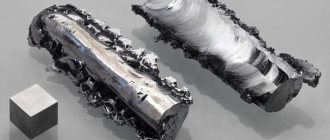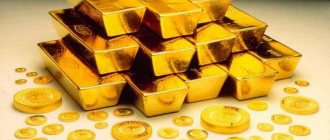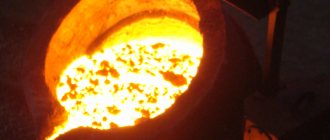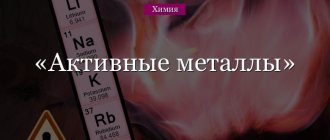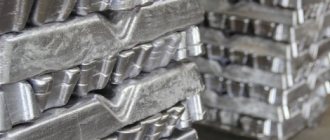Melting point of metals
Most of the elements in the periodic table are metals. There are currently approximately 96 of them. They all require different conditions to turn into liquid.
The heating threshold of solid crystalline substances, above which they become liquid, is called the melting point. For metals it varies within several thousand degrees. Many of them turn into liquid with relatively high heat. This makes them a common material for making pots, pans and other kitchen utensils.
Silver (962 °C), aluminum (660.32 °C), gold (1064.18 °C), nickel (1455 °C), platinum (1772 °C), etc. have average melting points. There is also a group of refractory and low-melting metals. The first need more than 2000 degrees Celsius to turn into liquid, the second need less than 500 degrees.
Low-melting metals usually include tin (232 °C), zinc (419 °C), and lead (327 °C). However, some of them may have even lower temperatures. For example, francium and gallium melt in the hand, but cesium can only be heated in an ampoule, because it ignites with oxygen.
The lowest and highest melting temperatures of metals are presented in the table:
| Refractory | Low-melting | ||
| Tungsten | 3422 °C | Mercury | -38.87 °C |
| Rhenium | 3186 °C | Gallium | 26.79 °C |
| Tantalum | 3017 °C | France | 27 °C |
| Osmium | 3033 °C | Cesium | 28.5 °C |
| Molybdenum | 2623 °C | Rubidium | 39.31 °C |
| Niobium | 2477°C | Potassium | 63.5 °C |
| Iridium | 2466 °C | Sodium | 97.8 °C |
Classification
Depending on the melting point, refractory metals are assigned to the main or additional group.
Main group
This segment includes five positions: tungsten, niobium, tantalum, molybdenum, rhenium.
Melts at 2200°C+. Properties of the fourth group of elements
| Name | Niobium | Molybdenum | Tantalum | Tungsten | Rhenium |
| Melting temperature | 2750 K (2477 °C) | 2896 K (2623 °C) | 3290 K (3017 °C) | 3695 K (3422 °C) | 3459 K (3186 °C) |
| Boiling temperature | 5017 K (4744 °C) | 4912 K (4639 °C) | 5731 K (5458 °C) | 5828 K (5555 °C) | 5869 K (5596 °C) |
| Density | 8.57 g cm³ | 10.28 g cm³ | 16.69 g cm³ | 19.25 g cm³ | 21.02 g cm³ |
| Young's modulus | 105 GPa | 329 GPa | 186 GPa | 411 GPa | 463 GPa |
| Vickers hardness | 1320 MPa | 1530 MPa | 873 MPa | 3430 MPa | 2450 MPa |
Molybdenum
The most popular of the refractory elements.
The number one area of use is metallurgy:
- Molybdenum is used to “strengthen” steel to produce a hard alloy.
- Together with stainless steel, it is used as a material for the infrastructure of pipelines, car parts, and other mechanical engineering products.
- Due to its melting point, wear resistance, and low abrasion, it is used as an alloying additive.
For example, half a percent titanium plus 0.08% zirconium creates a molybdenum alloy that does not lose strength up to 1060°C.
Extraordinary friction parameters have led to the use of molybdenum as a long-lasting lubricant with high efficiency.
The material is indispensable for mercury relays, since an amalgam with this metal is not formed by mercury.
Tungsten
Opened at the end of the 18th century. The hardest and most refractory (3422°C) metal.
Refractory durable metal, light gray in color - tungstenTogether with copper and iron, it is used as the basis (up to 80%) of alloys with rhenium, thorium, and nickel. Such additives increase density, rust resistance threshold, and reliability.
It is in demand as a material for power supply systems, instruments, ammunition, and nuclear missile warheads. Nickel alloys are valued by golf fans as club materials.
Tungsten ingots
Tantalum
The most resistant to acids and corrosion from the segment of refractory metals.
Heavy, hard metal of gray color – tantalum
Therefore, it is used in capacitors of smartphones, tablets, and other gadgets.
Compatible with biological organisms (does not change under the influence of natural acids). Because of this, it is used in medicine.
Niobium
Metal with unusual characteristics:
- The lightest (low density) in the segment.
- It is unique due to its ability to change the coefficient of hardness and elasticity depending on the degree of annealing.
- Most common in superconducting alloys.
It is used as a material for capacitors, gas turbines, rockets, and aircraft. As well as an element of nuclear reactors and lamps of electronic devices.
Rhenium
The rarest and most expensive of the refractory metals:
- In alloys it acts as an alloying component, never as a main component.
- As an alloy, it increases the utilitarian qualities of the alloy: strength, malleability (for example, with copper and platinum).
- Found last in the refractory segment.
Alloys with rhenium serve as catalysts, filling electronic equipment, gyroscopes, and reactors of nuclear facilities.
Additional group
This segment of refractory metals includes nine positions. Their common feature is the melting threshold of 1850°C.
This includes nine elements from three groups (fourth – sixth periods) of the periodic table.
Each has its own “zest”:
- Osmium is the densest substance on the planet, the heaviest refractory.
- Iridium is found more often in meteorites than on Earth.
- Metamorphoses of the heat capacity of hafnium are still inexplicable by science.
- Ruthenium is named after Russia.
- Pure vanadium is used to make tokens and medals for collectors.
- Titanium is the only refractory non-ferrous metal. Material of dental and bone prostheses.
- Without zirconium, fireworks and fireworks are impossible. Medical "understudy" of titanium.
A thin layer of chrome and noble rhodium is used to cover the surface of luxury products, including jewelry. The processes are called chrome plating and rhodium plating.
Tungsten
Tungsten metal has the highest melting point. Only the nonmetal carbon ranks higher in this indicator. Tungsten is a light gray shiny substance, very dense and heavy. It boils at 5555 °C, which is almost equal to the temperature of the Sun's photosphere.
At room conditions, it reacts weakly with oxygen and does not corrode. Despite its refractoriness, it is quite ductile and can be forged even when heated to 1600 °C. These properties of tungsten are used for incandescent filaments in lamps and picture tubes and electrodes for welding. Most of the mined metal is alloyed with steel to increase its strength and hardness.
Tungsten is widely used in the military sphere and technology. It is indispensable for the manufacture of ammunition, armor, engines and the most important parts of military vehicles and aircraft. It is also used to make surgical instruments and boxes for storing radioactive substances.
Mercury
Mercury is the only metal whose melting point is minus. In addition, it is one of two chemical elements whose simple substances, under normal conditions, exist in the form of liquids. Interestingly, the metal boils when heated to 356.73 °C, and this is much higher than its melting point.
It has a silvery-white color and a pronounced shine. It evaporates already at room conditions, condensing into small balls. The metal is very toxic. It can accumulate in human internal organs, causing diseases of the brain, spleen, kidneys and liver.
Mercury is one of the seven first metals that man learned about. In the Middle Ages it was considered the main alchemical element. Despite its toxicity, it was once used in medicine as part of dental fillings, and also as a cure for syphilis. Now mercury has been almost completely eliminated from medical preparations, but it is widely used in measuring instruments (barometers, pressure gauges), for the manufacture of lamps, switches, and doorbells.
Alloys
To change the properties of a particular metal, it is alloyed with other substances. Thus, it can not only acquire greater density and strength, but also reduce or increase the melting point.
An alloy can consist of two or more chemical elements, but at least one of them must be a metal. Such “mixtures” are very often used in industry, because they make it possible to obtain exactly the qualities of materials that are needed.
The melting point of metals and alloys depends on the purity of the former, as well as on the proportions and composition of the latter. To obtain low-melting alloys, lead, mercury, thallium, tin, cadmium, and indium are most often used. Those containing mercury are called amalgams. A compound of sodium, potassium and cesium in a ratio of 12%/47%/41% becomes a liquid already at minus 78 ° C, an amalgam of mercury and thallium - at minus 61 ° C. The most refractory material is an alloy of tantalum and hafnium carbides in 1:1 proportions with a melting point of 4115 °C.
Records in science and technology. Particles and substances
All known matter on Earth and beyond is composed of chemical elements. It is estimated that there are 1087 electrons in the known Universe.
The total number of naturally occurring elements is 94.
At normal temperature, 2 of them are in the liquid state, 11 are in the gaseous state and 81 (including 72 metals) are in the solid state.
The so-called “fourth state of matter” is plasma, a state in which negatively charged electrons and positively charged ions are in constant motion.
The lightest and most massive elementary particles
By April 1988, science knew of the existence of 31 stable particles, 64 meson multiplet resonances and 52 baryon multiplet resonances, which could ultimately lead to the discovery of 247 elementary particles, as well as an equal number of antiparticles.
The most massive commonly accepted particle is the 92.4 GeV neutral intermediate vector boson Z0, first discovered in May 1983.
Laboratory UA-1 of the European Organization for Nuclear Research (CERN), Geneva, Switzerland, operating at the proton-antiproton collider SPS (ultra-high energy proton synchrotron) with a beam energy of 540 GeV.
The most massive hadron is considered to be a σ-meson resonance (6S) (mass 11.02 GeV, lifetime 8.3 × 10–24 s), consisting of a beauty quark (b-quark) or a down quark (d-quark) and his antique.
It was first discovered by two groups working at the Electronic Storage Ring at Cornell University, Ithaca, New York, USA.
According to the modern theory of elementary particles, the mass of the graviton, photon and neutrino should be equal to zero.
According to estimates corresponding to various cosmological theories, the upper limits of the mass of these particles are 7.6 10–67 g for the graviton, 5.3 10–60 g for the photon and 3.2 10–32 g for the neutrino (average mass electron is 9.10939·10–28 g).
Most and least stable
From the “grand unified theory”, which describes weak, electromagnetic and strong interactions, it follows that the proton is unstable. However, according to experimental results published in 1986.
, the lifetime of a proton in the case of the most probable method of its decay (into a positron and a neutral pion) has a lower limit of 3.1·1032 years, which is more than 40 times longer than the maximum lifetime predicted by theory.
The most unstable or shortest-lived particles are the two baryon resonances N (2220) and N (2600), whose lifetime is 1.6 10–24 s, while the theoretically predicted lifetime of the intermediate vector bosons W± and Z0 is 2.6 ·10–25 s.
Newest particles
The newest particles are χ-meson resonances (2P), the discovery of which was announced in 1987 by a joint group of Columbia and New York (Stony Brook, New York, USA) universities.
The scientists used electronic storage rings from Cornell University, Ithaca, New York, USA.
Mesons consist of a b quark and its antiquark and have masses of 10.235 GeV (χb0), 10.255 GeV (χb1) and 10.269 GeV (χb2).
Most offensive substance
The most foul-smelling of the 17 thousand.
The substances registered so far in the world are, although this may be subjective, ethyl mercaptan (C2H5SH) and butyl selenomercaptan (C4H9SeH).
The smell of each of them is reminiscent of a mixture of rotting cabbage, garlic, onions, burnt toast and sewer gases.
The most expensive perfumes
The retail price of a perfume is determined more by advertising considerations than by the cost of components and packaging.
Chicago began selling in March 1984.
a cologne called Andron, containing trace levels of the attractant pheromone androstenol, priced at $97 per gram.
The most powerful poison
The disease rickettsiosis, or Q fever, can be caused by a single microorganism. However, only in one case out of a thousand does it lead to death.
About 10 organisms, Francisella tularenesis (formerly Pasteurella tularenesis), can cause the disease tularemia, variously called alkali disease, Francis disease, or “deer fly fever.” It causes death in 10 cases out of a thousand.
The most powerful nerve gas
VX gas is 300 times more toxic than phosgene (COCl2) used during the First World War. It was created at the Chemical Defense Experimental Laboratories, Porton Down, UK, in 1952.
Patent applications were filed in 1962 and published only in February 1974. They stated that the substance was ethyl S-2-diisopropylaminoethyl methyl phosphonotylate.
The lethal dose is 10 mg min/m3 in air or 0.3 mg orally.
The most powerful absorbent
August 18, 1974
The US Department of Agriculture Research Service announced the creation of a superabsorbent called “H-span”, which contains 50% starch derivative and 25% each of acrylamide and acrylic acid. After treatment with iron, the absorbent is able to absorb a mass of water 1300 times greater than its own mass.
The finest powder
The grinding limit is solid helium, which, as was established back in 1964, should be a monoatomic powder.
The most poisonous artificial substance
TCDD, or 2, 3, 7, 8-tetrachlorodibenzo-p-dioxin, discovered in 1872, is lethal at a concentration of 3.1 × 10–9 mol/kg, which is 150 thousand times stronger than a similar dose of cyanide.
The most refractory substance
Tantalum carbide TaC0-88 melts at a temperature of 3990°C.
Substance with the lowest density
The substance with the lowest density are silicon aerogels, in which spheres of bonded silicon and oxygen atoms form long strands separated by air layers. In February 1990, at the National Laboratory.
Lawrence Livermore, California, USA, the lightest of these aerogels was obtained with a density of only 0.005 g/cm3.
This substance is supposed to be used in space research to collect micrometeorites present in the tails of comets.
Substance with the highest superconducting temperature
In March 1988, the phenomenon of superconductivity was observed at the IBM Research Center in San Jose, California, USA, at a temperature of –148°C. The conductor was a mixture of oxides of thallium, calcium, barium and copper - Тl2Са2Ва2Сu3О x
.
The sweetest substance
Talin, obtained from the husk of katemfe (Thaumatococcus Daniellii), found in West Africa, is 6150 times sweeter than a 1% sucrose solution.
The most bitter substance
The bitter taste of Vilex (denatonium benzoate) is felt when one part of it is dissolved in 100 million parts of the solution.
Previously published:
Guinness Book of Records, 1998
February 3, 2002
Electronic version:
© NiT. Articles, 1997
Source: https://nt.ru/tp/in/rnt01.htm
